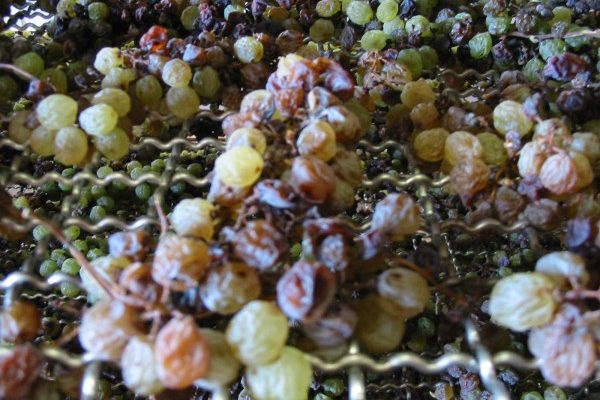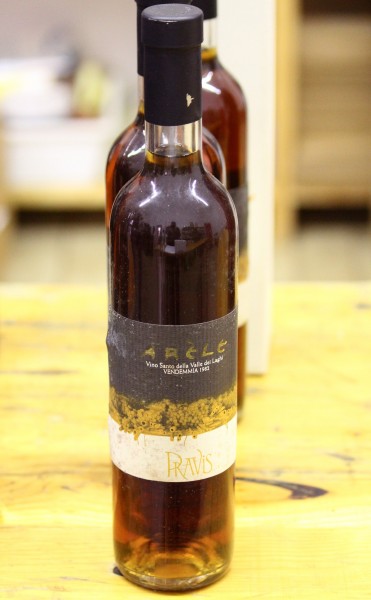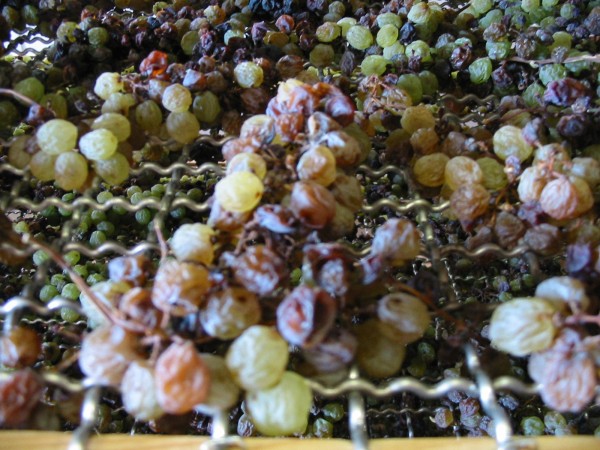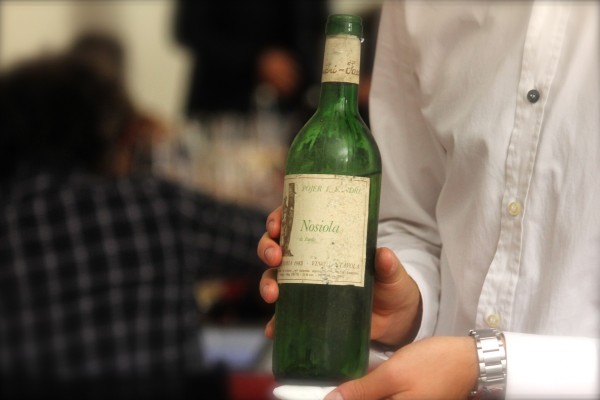Almost all Italian wine regions have a wonderful tradition of “medicinal wine” used to restore strength to new mothers, to accelerate healing in those who are suffering from a bad flu, and to nourish old people. In Trentino, the wine to be uncorked “in case of sickness” or, as they say in the local language, “in casi di mali,” is the Vino Santo, a sweet white wine that is now rather rare; today it has a very limited annual production of less than 50,000 bottles (and those are “half” bottles, of 330 ml).
Only six wineries in Trentino still make this wine. Obviously, in the past there were many more because Vino Santo was once in great demand on the Austrian and German markets — don’t forget that until 1918 the Trentino region was part of the large Austro-Hungarian Empire. After the end of the First World War, with the fall of this Empire, the market for Vino Santo also collapsed and only the tenacity of a handful of small producers prevented this wine from completely disappearing. The decline of the Vino Santo market, in turn, threatened the grape Vino Santo was made with. This grape is called nosiola (from nocciola, the Italian word for hazelnut).
It is very difficult to find any record of the history of this variety before the beginning of the 19th century, but its origins are quite probably in Northern Italy, around the Trento provinces, where it was described by the naturalist Giuseppe Acerbi in 1825.
It was widely cultivated until the 1980s, as were other native grapes such as enantio, moscato rosa, marzemino and schiava. At the time, these vineyards made up over 60% of the planted area in the region, but now, this is no longer the case. For nosiola, as well: in 1970 there were 46,000 tons a year of nosiola, now there are barely 9,000 tons. The vineyards are mainly located in nosiola’s classic production area: on the hills around Toblino, in the Lavis and Cembra valley and particularly in the Valle dei Laghi. Here, a warm breeze called Ora del Garda that comes up late in the evening creates the ideal microclimate for full maturation of the grapes.
Even so, sadly, the cultivation of nosiola is decreasing year after year. Nosiola vines that die are not replaced, and large cooperatives, which in this region are responsible for the lion’s share of wine production, prefer to cultivate pinot noir and chardonnay though these grapes became popular here relatively recently. After all, why invest in nosiola? It is not an extremely aromatic variety, which is so trendy nowadays. Its aromas are delicate, and its flavors are not pronounced. Who will enjoy this type of wine today, Trentino’s nosiola producers must have wondered/ But every wine has a story behind it, and a specific character nature, which emerges only in the right conditions.
“Nosiola is the expression of Trentino, of its land, its herbs, its people,” declares Arrigo Pisoni, owner of the organic winery Pisoni. “It is a fragrant, light wine, a bit tart, with hints of apple. All white wines here reflect the land and the working people. The ideal soils for nosiola are sunny, dry, stony with limestone, where the grapes can grow sparse and golden.” And the bunches can have two different purposes: they can be made into the precious and sweet Vino Santo, or the white wine Trentino Nosiola DOC.
“The double gift of this grape is really undervalued,” continues Pisoni. “Nosiola is the wine for mid-morning snacks, like the ones that people use to have in Alto Adige, with black bread and bacon. However, even Giulio Ferrari, at the beginning of his adventure into the world of classic-method sparkling wines, used nosiola in his blend, before the introduction of chardonnay here.”
Usually, in the Trentino region, nosiola is vinified alone, but it can also be found blended with other grapes; the wine Sorni for example, is made with nosiola, muller thurgau and pinot bianco.
Nosiola, at the moment, is a variety waiting to be (re-)discovered. To prove that it can offer some lovely surprises, a group of wine producers from Trentino, members of the Italian Federation of Independent Vignerons, recently organized an interesting tasting in the town of Riva del Garda, on Lake Garda: a journey through time, from to the present.
“Nosiola is the most fascinating variety of Trentino,” wine producer Alessandro Poli announced confidently. “It is a wine consistent with modern tastes because it is never very strongly alcoholic. When it is young, you appreciate it for its pleasant acidity and freshness, but when aged it has notes more similar to riesling.”
Among the many wines tasted during this event, the following caught my attention:
2008 Francesco Poli Nosiola Maiano Bianco
This wine producer manages his vineyards organically, and the 2008 vintage was very difficult due to a rainy, late spring, and hot and humid summer. However, this Nosiola exhibits a lovely pale, shiny straw color, while the nose offers scents of cream, white chocolate, fresh honey and beeswax. In the mouth it is quite coherent and structured, fruity, and with a final of fresh hazelnut, very good.
2001 Pravis, Nosiola L’Ora
The color is straw yellow, the nose is a bit smoky, with a hint of riesling-like aromas. In the mouth it is even better: complex, smooth, with multi-faceted aromas of dried fruit. It is also well-structured and rich, and finishes on fruity notes of surprising freshness.
1983 Pojer & Sandri, Nosiola
The oldest wine of this tasting shows how long a Nosiola can age while maintaining its drinkability. Straw color in the glass, with honeyed and riesling-style notes on the nose. On the palate it has a taste of yellow fruits that finish on a still-vibrant note of acidity.
[author] [author_image timthumb=’on’]http://palatepress.com/wp-content/uploads/2010/02/162f729-e1266674226608.jpg[/author_image] [author_info]Elisabetta Tosi is a freelance wine journalist and wine blogger. She lives in Valpolicella, where the famous red wines Amarone, Ripasso, and Recioto are produced. Professionally, she serves as a web-consultant for wineries, and in her free time writes books about Italian wines. She is also a contributor to Vino Pigro.[/author_info] [/author]




